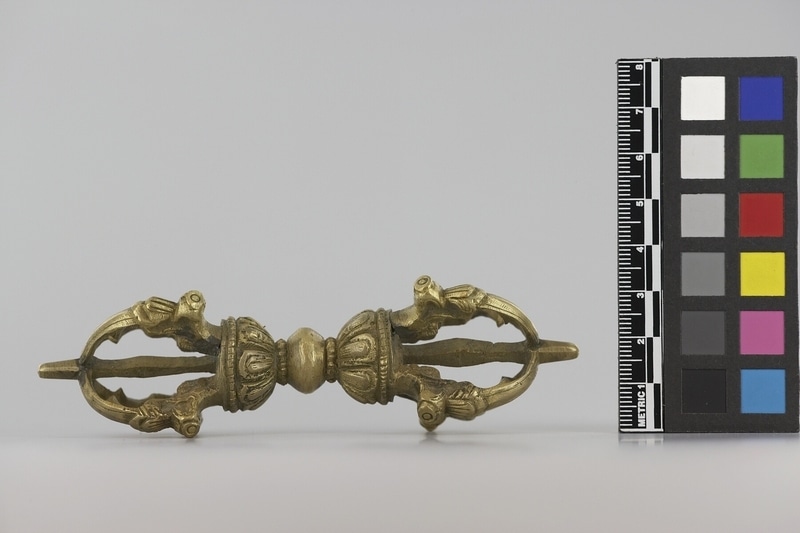Vajra Item Number: 1707/2 from the MOA: University of British Columbia


Description
Central spoke running through two inverted crown-shaped structures, both attached at centre by a flattened globe. Each crown-shaped part has four outside curved bars with plant motifs and a plain inner spoke.
History Of Use
Om Mani Padme Han, the Jewel in the Lotus, is the six-syllable mantra chanted by Tibetans to end the rebirth cycle in order to enter nirvana, the state of enlightenment. The predominant religion of Tibet is the Tantric, or Vajrayana, form of Buddhism. Tibetan art has a religious function, with a profusion of specialized ritual objects to aid the worshipper. These objects are produced by skilled craftsmen. During the ritual process a lama, or priest, would hold a vajra, or thunderbolt, in one hand and a ghanta, or prayer bell, in the other. He would unite the symbolic qualities the two objects represented by crossing his arms over his chest.
Cultural Context
Tibetan Buddhist religious symbol.
Iconographic Meaning
The vajra, or thunderbolt, symbolizes compassion. The crossing of the vajra and ghanta represented the enlightened mind.
Item History
- Made in Tibet between 1800 and 1900
- Owned by Phuntsok Kakho before December 20, 1996
- Received from Phuntsok Kakho (Donor) on December 20, 1996
What
- Name
- Vajra
- Identification Number
- 1707/2
- Type of Item
- vajra
- Material
- bronze metal
- Overall
- height 11.0 cm, diameter 4.0 cm
Who
- Culture
- Tibetan
- Previous Owner
- Phuntsok Kakho
- Received from
- Phuntsok Kakho (Donor)
Where
- Holding Institution
- MOA: University of British Columbia
- Made in
- Tibet
When
- Creation Date
- between 1800 and 1900
- Ownership Date
- before December 20, 1996
- Acquisition Date
- on December 20, 1996
Other
- Item Classes
- metalwork
- Condition
- good
- Current Location
- Case 81
- Accession Number
- 1707/0002